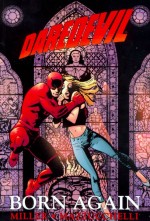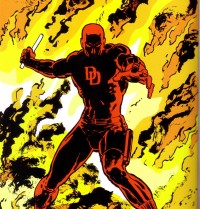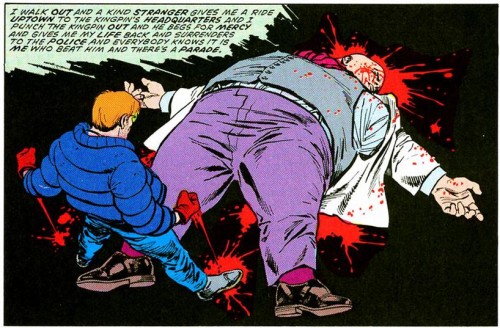“It’s the eighties. You do what you have to. And you have to do it”
 When Denny O Neil left Daredevil in the mid 80’s Frank Miller was asked to return to the title that made his name. Bringing Year One alumni, David Mazzucchelli, with him to handle pencilling duties Miller scripted Born Again, a story that, for me, is the high point of his career. Choosing to focus on Matt Murdock rather than Daredevil (the red costume only appears at the start and the end of the tale), Born Again starts with Karen Page selling the secret identity of Daredevil, her ex-lover Matt Murdock, for an armful of heroin. This information then works its way up the criminal supply chain till it reaches The Kingpin, who uses it to take away everything Murdock has causing him to sink lower and lower until he hits rock bottom. It is only then that Murdock finds help from the most unexpected of places, giving him the strength to start over.
When Denny O Neil left Daredevil in the mid 80’s Frank Miller was asked to return to the title that made his name. Bringing Year One alumni, David Mazzucchelli, with him to handle pencilling duties Miller scripted Born Again, a story that, for me, is the high point of his career. Choosing to focus on Matt Murdock rather than Daredevil (the red costume only appears at the start and the end of the tale), Born Again starts with Karen Page selling the secret identity of Daredevil, her ex-lover Matt Murdock, for an armful of heroin. This information then works its way up the criminal supply chain till it reaches The Kingpin, who uses it to take away everything Murdock has causing him to sink lower and lower until he hits rock bottom. It is only then that Murdock finds help from the most unexpected of places, giving him the strength to start over.
Born Again is not a happy story. It’s the sort of grim tragedy that was Frank Miller’s stock and trade in the 80’s but it’s also the perfect showcase of his talents. Each character in Born Again has a well-defined arc, with a beginning, middle and end that fall together in such a way that even the smallest touches, such as Foggy Nelson getting a new job have an impact on Murdock’s fall from grace. What’s more Miller writes Murdock, and his enhanced perceptions, in a way that makes Hell’s Kitchen come alive. Electricity hums, horns blare, ribs pop, the reader gets to experience what it is truly like to be Matt Murdock and so, when his world collapses, we feel it all the more keenly.
Given that Miller was just as famous for drawing Daredevil it’s a wonder he didn’t pencil Born Again too but David Mazzuchelli’s art, coupled with Christie Scheele and Richmond Lewis’s colours, brings a sense of realism to the table that Miller’s artwork lacks. It’s not that Miller’s artwork is bad, but his characters often look a little cartoony whereas Born Again is a more grounded story. As such Mazzucchelli’s art lends Millers narrative a sense of grandeur without losing touch of its more human elements.
The title Born Again has obvious religious connotations and the book is draped in Judeo Christian symbolism (Murdock’s walk through Manhattan in chapter 3 mirrors the Stations of the Cross and the start of Chapter 4 finds the Devil striking a particularly Jesus Christ pose) but Miller and Mazzucchelli are actually concerned with a more material idea in Born Again, which is the divide between the rich and poor and the influence that those with money have over those in power and how they use it to affect the lives of those with none of either.
In the early 1980’s America had experienced the worst recession since The Great Depression. Unemployment had been high and budget cuts across the country, as well as some insensitive statements by then president Ronald Regan, had left the working classes feeling that the people in charge were out of touch with their needs. Miller and Mazzucchelli play on these ideas from the outset. Starting in a crack den on page 1 before moving to the upper levels of a skyscraper on page 2 and then a yacht owned by the Kingpin on page 3 Born Again constantly contrasts the Haves with the Have Nots. The Kingpin is always surrounded by his ill-gotten wealth in panels that are a stark contrast to panels showing Murdock’s physical and mental decline. Miller also used Born Again to revisit the disust of those in power, a theme he had touched upon in The Dark Knight Returns. Even though details of the Iran Contra affair hadn’t hit the news at the time of Born Again’s publication in 1986 it’s hard not to see an echo of the scandal in the story’s conclusion as Hell’s Kitchen gets turned into a warzone when the Kingpin utilises a super powered government tool for his own devices.
With its focus on wealth and poverty, as well as its suspicions of government control, it’s easy to see why Born Again still resonates with modern readers. However it isn’t entirely perfect. I often refer to it as the first part of the Karen Page Trilogy and yet reading it again I see what a rough deal she gets throughout the story. Frank Miller has never been kind to women in his writing and Born Again is no exception as the female characters always seem to require saving by a man. It is somewhat ironic that for a book whose ideas that are still relevant decades later its treatment of women dates the book more than anything. But it’s ok, things turn out quite well for Karen because she goes to Matt and asks him for help and this is where we hit upon another interesting point.
At his lowest ebb, Matt sees Foggy as abandoning him for his new job and girlfriend (who also happens to be Matt’s ex), but in truth Foggy never stops looking for his friend. Matt can’t see this because he is blinded by his circumstances and it’s not until Matt accepts help that he is able to pull himself out of the hole he’s fallen into and start again. The same is true of Ben Ulrich, who finds the courage to speak out, and this is core theme of the book: Times are hard and it’s ok to ask for help if you’re in need and that if we all chip in and help each other we might just be able to make things better between us all and that if you see the Haves exploiting the Have Nots then you need to stand up and say something…
 … Which makes it all the harder to understand why, 25 years later Miller wrote a, quite frankly insane, diatribe criticising people for doing exactly that. But hey who am I to question “the goddamn Frank Miller”? (Copyright Seb Carey 2015).
… Which makes it all the harder to understand why, 25 years later Miller wrote a, quite frankly insane, diatribe criticising people for doing exactly that. But hey who am I to question “the goddamn Frank Miller”? (Copyright Seb Carey 2015).
Either way Born Again is a classic that is well worth your time and can be purchased from all good retailers or borrowed from Jon.

